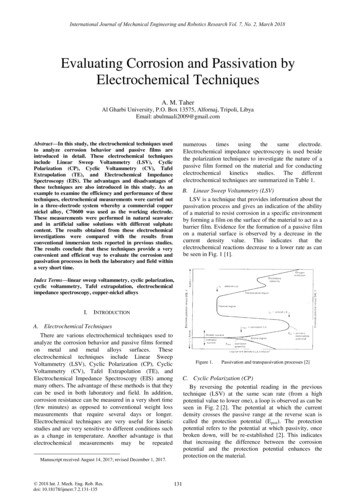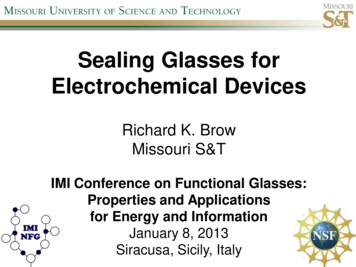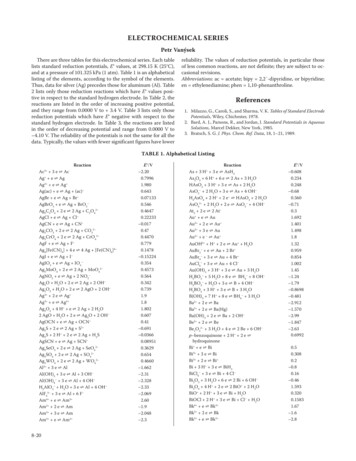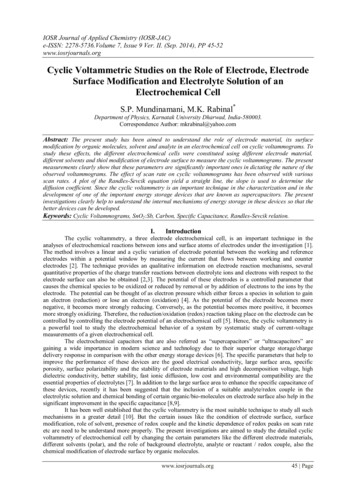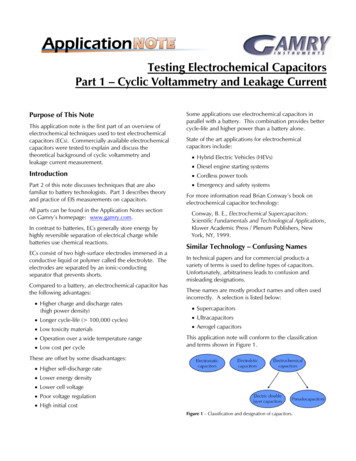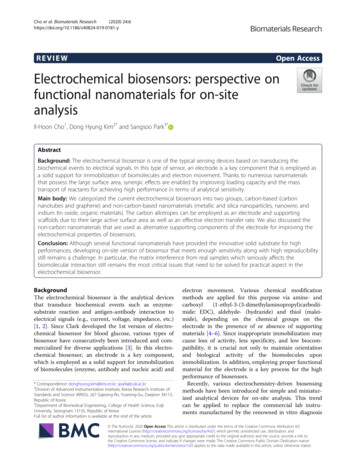
Transcription
Cho et al. Biomaterials Research(2020) WOpen AccessElectrochemical biosensors: perspective onfunctional nanomaterials for on-siteanalysisIl-Hoon Cho1, Dong Hyung Kim2* and Sangsoo Park3*AbstractBackground: The electrochemical biosensor is one of the typical sensing devices based on transducing thebiochemical events to electrical signals. In this type of sensor, an electrode is a key component that is employed asa solid support for immobilization of biomolecules and electron movement. Thanks to numerous nanomaterialsthat possess the large surface area, synergic effects are enabled by improving loading capacity and the masstransport of reactants for achieving high performance in terms of analytical sensitivity.Main body: We categorized the current electrochemical biosensors into two groups, carbon-based (carbonnanotubes and graphene) and non-carbon-based nanomaterials (metallic and silica nanoparticles, nanowire, andindium tin oxide, organic materials). The carbon allotropes can be employed as an electrode and supportingscaffolds due to their large active surface area as well as an effective electron transfer rate. We also discussed thenon-carbon nanomaterials that are used as alternative supporting components of the electrode for improving theelectrochemical properties of biosensors.Conclusion: Although several functional nanomaterials have provided the innovative solid substrate for highperformances, developing on-site version of biosensor that meets enough sensitivity along with high reproducibilitystill remains a challenge. In particular, the matrix interference from real samples which seriously affects thebiomolecular interaction still remains the most critical issues that need to be solved for practical aspect in theelectrochemical biosensor.BackgroundThe electrochemical biosensor is the analytical devicesthat transduce biochemical events such as enzymesubstrate reaction and antigen-antibody interaction toelectrical signals (e.g., current, voltage, impedance, etc.)[1, 2]. Since Clark developed the 1st version of electrochemical biosensor for blood glucose, various types ofbiosensor have consecutively been introduced and commercialized for diverse applications [3]. In this electrochemical biosensor, an electrode is a key component,which is employed as a solid support for immobilizationof biomolecules (enzyme, antibody and nucleic acid) and* Correspondence: donghyung.kim@kriss.re.kr; spark@eulji.ac.kr2Division of Advanced Instrumentation Institute, Korea Research Institute ofStandards and Science (KRISS), 267 Gajeong-Ro, Yuseong-Gu, Daejeon 34113,Republic of Korea3Department of Biomedical Engineering, College of Health Science, EuljiUniversity, Seongnam 13135, Republic of KoreaFull list of author information is available at the end of the articleelectron movement. Various chemical modificationmethods are applied for this purpose via amine- diimide: EDC), aldehyde- (hydrazide) and thiol (maleimide), depending on the chemical groups on theelectrode in the presence of or absence of supportingmaterials [4–6]. Since inappropriate immobilization maycause loss of activity, less specificity, and low biocompatibility, it is crucial not only to maintain orientationand biological activity of the biomolecules uponimmobilization. In addition, employing proper functionalmaterial for the electrode is a key process for the highperformance of biosensors.Recently, various electrochemistry-driven biosensingmethods have been introduced for simple and miniaturized analytical devices for on-site analysis. This trendcan be applied to replace the commercial lab instruments manufactured by the renowned in vitro diagnosis The Author(s). 2020 Open Access This article is distributed under the terms of the Creative Commons Attribution 4.0International License (http://creativecommons.org/licenses/by/4.0/), which permits unrestricted use, distribution, andreproduction in any medium, provided you give appropriate credit to the original author(s) and the source, provide a link tothe Creative Commons license, and indicate if changes were made. The Creative Commons Public Domain Dedication o/1.0/) applies to the data made available in this article, unless otherwise stated.
Cho et al. Biomaterials Research(2020) 24:6(IVD) companies which claim high sensitive measurement of analytes and automation. However, developingan ideal on-site version of the biosensor to meet a required sensitivity along with high reproducibility still remains a challenge. Employing functional nanomaterialsused as a supporting matrix for signal enhancement hasgained attention for high-performance electrochemicalanalysis [7]. Nanomaterials endow the large surface area,enabling support increased loading capacity and themass transport of reactants, which results in a synergicinfluence for signal amplification [8].Here, we primarily focus on the functional nanomaterials (carbon-based and non-carbon-based) which wereemployed in the diverse forms of electrochemical biosensor for improving an analytical performance in termsof sensitivity as shown in Fig. 1. The nanomaterialsemployed as electrodes or assisting matrices should meetthe following requirements for signal enhancement:assisting electro-catalytic property, outstanding electronmovement capability and great biocompatibility withcapture biomolecules. The nanomaterial incorporatingelectrochemical strategies can be applied for both apaper and a microfluidic type of biosensor applications,which are practical sensing platforms for point-of-careversion of biomolecular detection.Carbon-based nanomaterialsCarbon-based nanomaterials are very useful and havebeen applied to diverse industrial fields [9]. Here, weintroduce the current electrochemical biosensors employing carbon nanomaterials, e.g., carbon nanotube (CNT)and graphene for analytical improvement (Table 1). CNTscan be used as an electrode structure because of theirextraordinary mechanical stability, large surface area, andremarkable electrical conductivity caused by orbitalhybridization (sp2 type) between adjacent carbon atomsPage 2 of 12[10]. There are two types of CNTs: single-walled andmulti-walled carbon nanotube. Graphene, a 2-dimensionalhexagonal pattern of carbon atoms, can also be adopted asan electrode due to its higher specific surface area thanCNTs [5]. However, graphene has a low throughput andhydrophobicity, which limits its usability in biosensor applications [11]. Graphene oxide (GO) and reduced graphene oxide (rGO) solved the problems by increasinghydrophilicity of the graphene layer and eliminating theoxygen groups of GO, achieving an extraordinary electrical conductivity and ease of surface modification forimmobilization of biomolecules [12].Single-wall carbon nanotubesRecently, single-walled carbon nanotubes (SWCNTs)commonly used in biosensor to enhance electrical properties. SWCNTs have great electronic and mechanicalcharacteristics [26]. Due to its physicochemical properties, the SWCNTs have gained great attention in electrochemical biosensors [27]. Its huge surface area couldincrease the quantity of the immobilized enzymes, widenthe reaction areas between the enzyme and the substrate, facilitate electrical conductivity and increase thesignal response of the biosensors [15]. All these properties claim that SWCNTs could be capable of stimulatingelectron-transfer reactions for several biological molecules. However, the insolubility of SWCNTs may beproblematic in biological applications. In order to overcome the stable insolubility in aqueous solutions, somenanocomposites with unique biocompatibility propertieshave been adopted with SWCNT [28, 29]. In addition,polymer nanocomposite incorporating carbon nanotubesis electrically conductive when the content of the filler ishigher than the critical level [7].Mao et al. described a simple, label-free electrochemical impedance spectroscopic technique for sequencing-Fig. 1 Scheme of analytical principle for electrochemical biosensors based on carbon and non-carbon nanomaterials
Cho et al. Biomaterials Research(2020) 24:6Page 3 of 12Table 1 Summary of representative carbon-based nanomaterials used in electrode and label of electrochemical biosensorMaterialsAdvantageLimitationsFeatureLimit of detectionRef.SWCNTLarge surface area tovolumeratio (S/V)Low charge-carried densityDelocalized π-orbitalsElectrical conductivityimprovementsLimited surface to interfacewith large biological componentsNonspecific adsorption of proteinDifficult manipulation during sensorfabrication processDifficult chemical functionalizationElectrodeDeoxyriboNucleic acid (DNA)71 pM[13]ElectrodeGlucose7.06 μA/mM[14]Electrodeaflatoxin B1 (AFB1)0.01 nM[15]ElectrodeAnti-IgG0.2 pM[16]ElectrodeCarcinoembryonic antigen (CEA)0.0055 fM[17]ElectrodeTransforming growth factor beta 1 (TGF-β1)0.05 pM[9]ElectrodeProstate specific antigen (PSA)0.11 fM[18]ElectrodeMouse IgG0.066 pM[19]LabelPSA0.13 pM[20]Electrodedibutyl phthalate (DBP)0.025 μM[21]ElectrodePSA0.33 pM[22]ElectrodeCystatin C0.002 nM[23]LabelCry1C0.02 pM[24]LabelCEA0.003 pM[25]MWCNTGrapheneExcellent conducting andelectro-catalytic propertiesHigh S/VLarge active sitesFast electron transferHigh thermal conductivityBetter mechanical flexibilityGood biocompatibilityNeed to functionalize surfacefor increasing biocompatibilityIrreversible agglomerates inaqueous solutionHard to dissolve in waterspecific DNA detection using SWCNTs as support forthe DNA probe [30]. The SWCNTs are incorporatedinto gold electrodes with surface modification by selfassembled monolayers made of thiol derivatives. Thesingle-stranded DNA probe is anchored to the SWCNTssupport via covalent bonding between the -COOH inthe nanotubes and the -NH2 groups at the 5 ‘end of thessDNA. They claim that SWCNTs as supporting matrixfor probe DNA significantly increase the surface loadingcapacity on the electrode surface and therefore significantly lower the detection limit of target DNA. TheSWCNT and polypyrrole multilayer film on platinum,which is coated from polyvinylidene fluoride membranewas manufactured by Shirsat et al. [14], demonstratingthe feasibility of SWCNT-Polypyrrole multilayer biosensor for glucose monitoring. Here, a layer by layer formof polypyrrole and SWCNT provided a useful solidmatrix for enzyme immobilization, indicating a goodperformance with excellent linearity from 1 mM to 50mM of glucose concentration, and high sensitivity of7.06 uA/mM. In addition, an electrochemical sensor implemented on SWCNT combining screen printed electrodes [13] and glassy carbon electrode (GCE) [31] werealso introduced for better performances.Multi-functional SWCNTs provide a basis for novel biosensor systems incorporating the immobilization of distinctbiomolecules in combination with enzymes and redox mediators. Multiple functionalizations enable the coimmobilization of biomolecules and rigid spacers betweenSWCNTs to enhance the mechanical solidity of SWCNTstructures. Holzinger et al. researched multiple functionalizations of SWCNTs to create a polyvalent sensing electrode [32]. Three separate pyrene compounds aresimultaneously immobilized on the surface of the nanotubewith π-stacking a single-step process of basic dip coating.SWCNTs can also be used as an electrochemical mediator. Jiang et al. published a feasibility study for the terminal protection of small-molecule-linked DNA [33]. Dueto the fact that the SWCNTs adsorbed on the insulating16-mercaptohexadecanoic acid self-assembled monolayercould efficiently mediate electron transfer between theelectrode and electron mediator such as ferrocene carboxylic acid, a strong redox current was detected. Gutierrezet al. reported an electrochemical quantification detectionfor Cd (II) combined with a glass carbon electrode by dispersion of SWCNTs functionalized with cysteine [31].The functionalization of SWCNTs was achieved by the reaction between the carboxylic groups of oxidized SWCNT
Cho et al. Biomaterials Research(2020) 24:6and the amino groups of S-triphenylmethyl cysteine usinga benzotriazole-based binding chemistry agent to activatecarboxylic residues. Multi-functional SWCNTs providethe platform for new biological systems involvingimmobilization of different biomolecules exhibiting complementary activities or associations at the molecular levelof enzymes and redox mediators.As mentioned, SWCNTs have drawn tremendous interest due to their great mechanical, chemical and optoelectronic traits, making them attractive nanomaterial forvarious applications [34]. However, the as-producedSWCNTs have a wide distribution of different chiral species with different characteristics (e.g., electronic structures). Highly filtered and well-separated process is verycrucial to take full advantage of the SWCNTs [34]. Furthermore, SWCNT-based biosensors have also restrictedsurface area to interact with large biorecognition agentslike mammalian cells, control the sensor manufacturingprocess, and undergo chemical modification [10]. In particular, the non-specific protein adsorption on nanotubesis not desirable, particularly when using biological fluidsamples containing several co-existing proteins and lipids[35]. Therefore, more advanced sensors are required toaddress the practical issues related to blockage and unintended disruption induced by a non-specific binding effectthat directly affects the analytical performances (selectivityand sensitivity) of biosensor [10].Multi-wall carbon nanotubesMWCNT comprises multiple layers of concentric singlewalled graphene cylinders of which structure is supportedvia Van der Waals forces with an interlayer spacing of 3.4 Å[36]. The MWCNTs have a sidewall structure similar to thegraphite basal plane [37]. As a consequence, electron transfer speeds may be comparable to the graphite edge-planeelectrode. While MWCNTs are still known as a 1dimensional form of carbon, the unique properties presentinside single-walled and double-walled carbon nanotubesare not as prominent. Nevertheless, the MWCNTs with excellent conduction and electro-catalytic characteristics havealso been employed as a modified scaffold on the electrode(Table 1). The solid substrate for antibody immobilizationcan be changed by chemical treatment [36].As significant structural degradation of MWCNTs occurred during functionalization, including decapping atthe end of the tubes and slicing and breaking the lengthof MWCNTs, proper functioning of the MWCNT surface is critical. Oxygen-functionalized multi-walled carbon nanotube (f-MWCNT) has been provided for stableimmobilization by covalent bonding between the oxygenfunctional groups of f-MWCNT and -NH2 groups of theantibody [38]. Zheng and Zheng described that theimmobilization of the non-polar amino acid chain of gelatin at the side wall of MWCNT takes place byPage 4 of 12hydrophobic - hydrophobic forces, leading to a stable dispersion of MWCNT [39]. Also, other similar studies indicate that the strength of the MWCNT/gelatin dispersioncould be remarkably improved by increasing the amountof MWCNT [40, 41]. Viswanathan et al. reported a disposable electrochemical biosensor with polyethyleneiminewrapped MWCNT screen-printed electrode [17]. Thepositively charged polyethyleneimine chains were ionicallywrapped on the surface of carboxylic acid-modifiedMWCNT.Numerous enzyme biosensors have introduced CNTmodified electrodes as a multifunctional scaffold. Nonetheless, the CNT-modified electrode biosensors have beendocumented to a much smaller extent. This is likely because immobilization techniques for this altered electrodedepend mostly on direct adsorption or covalent linkagesthat may reduce the stability of biomolecules and the reproducibility of bioelectrodes. Anchez-Tirado et al. usedMWCNTs as an electrode modifier for the development ofa transforming growth factor - β1 (TGF-β1) immunosensor, involving the reaction of Cu(I)-catalyzed azide-alkynecycloaddition to synthesize alkyne-azide conjugates [9].Nanoparticle incorporating MWCNTs can be an alternative method to improve analytical performances. MingdangLi et al. introduced an ultrasensitive electrochemical biosensor employing the AuNPs hybrid MWCNTs-SO3H aselectrode material which was coupled mostly by the physisorption [18]. Xu et al. developed an amperometric glucosebiosensor by means of alternating electrostatic selfassembly of glucose oxidase and dendrimer-encapsulatedPt nanoparticles on MWCNTs [42]. Here, the outstandingelectrocatalytic behavior and the unique 3-D structure ofthe enzyme electrode resulted in a low limit of detectionwith wide linearity, great precision and improved operational stability.One of the main drawbacks of CNTs is that their manufacturing process is not fully controlled. Aggregation andlow uniformity are critical issues [43]. Furthermore, CNTsare typically insoluble, hindering their practical approaches.The MWCNTs in aqueous solution tends to form irreversible aggregation phenomenon by strong π -π stacking andvan der Waals forces, which severely restrict their use [18,43]. To this end, the MWCNT surfaces undergo chemicalmodification with sulfonic acid groups, hydroxyl groupsand carboxyl groups for increasing dispersity and uniformity of film on the electrode surfaces [44–46].GrapheneGraphene in the shape of a 2-D hexagonal lattice form hasreceived considerable attention [10]. Graphene has beenemployed in various areas of the biosensor, in particularfor electrochemical sensing platforms. Graphene has thesame intrinsic physicochemical characteristics as graphiteand CNT, including large surface area and multiple
Cho et al. Biomaterials Research(2020) 24:6functional sites. As shown in Table 1, it is preferable toother carbon-based nanomaterials on the basis of the following physicochemical properties: exceptional electrontransfer, improved thermal conductivity, mechanical stability and biocompatibility [47]. However, it is difficult forgraphene to dissolve in water and therefore its surfaceshould be modified with hydrophilic functional groupssuch as -COOH [47, 48]. This method facilitates improvedsolubility and molecular immobilization by known NH2COOH chemistry aided by 1-ethyl-3-(3-dimethylaminopropyl) carbodiimide (EDC). Also, reduced graphene (rGO)can also be used as a supporting solid substrate for ease ofsurface modification [10]. However, improving its reproducibility and reliability is a critical challenge for its highperformance analysis. With more sophisticated manufacturing methods, graphene is widely employed as an alternativeto traditional electrode used in the electrochemicalbiosensor.Graphene has been considered as the ideal supportsource for label-free biosensor due to its excellent electronic and mechanical properties [5]. Integrating metallicnanoparticles on highly conductive surfaces is desirable forthe manufacturing electrode owing to its huge surface area,electrical conductivity and enzyme immobilization capacity[5, 49]. In particular, chemically modified graphene contains numerous defects/vacancies and possesses functionalgroups, thereby acting as a highly desirable solid supportfor the immobilization of inorganic nanoparticles as well asenzymes with improved stability and loading efficiency.Han et al. introduced a label-free biosensor, which wasmanufactured with rGO/AgNP composites supporting material. Small AgNPs are more capable of improving theelectrical characteristics of rGO than large AgNPs [50]. Asmall molecule, e.g., sodium citrate, and a commonly usedreducing agent, were utilized to produce rGO/AgNP composites with improved electrical conductivity [22].Wu et al. reported gold nanoparticle dotted reduced graphene oxide (rGO-AuNP) which was used as a substratefor an aptamer biosensor [51]. Wang et al. reported a responsive acetylcholinesterase biosensor in combinationwith a screen-printed electrode modified with iron oxidenanoparticle [52]. Since the following advantages: large active surface area, effective electron transfer and affinity ofiron oxide for the phosphoric band, the nanocompositefilm has provided numerous active sites and microenvironments to facilitate reaction acetylcholinesterase and sustainenzymatic activity.The redox substrate, which facilitates a strong current signal, has paved the way to enhance the analytical performance[53]. GO was used to increase the electrical conductivity onthe surface and the stability of the 3-D porous structure,resulting in dual signal enhancement [54]. Wang et al. studied a label-free electrochemical biosensor for the quantitativedetection of alpha-fetoprotein [55]. MultifunctionalizedPage 5 of 12graphene (TB-Au-Fe3O4-rGO) was used to change the electrode surfaces to achieve the signal amplification of the electrochemical signal. Here, as a type of redox probe, toluidineblue (TB) produce the electrochemical signal. Trindade et al.developed an electrochemical sensor with intrinsic redox behavior mediated by ferrocene for Cystatin C, an early renalfailure biomarker, on a functionalized graphene base [23].The current response was mediated by GO-ferrocene nanofilm with redox activity from surface-confined electroactivespecies.Nanocomposite and nanohybrid can often show improved physicochemical properties [56–59]. A novel twodimensional all-carbon nanocomposite electrode platformon the basis of ordered mesoporous carbon and fullerenecan significantly accelerate the electron transfer rate andprovide effective electrochemical sensing [60]. All carbonnanotubes and graphene are very suitable for electroanalysis [61, 62]. Therefore, the fusion of 1-D CNTs with 2-Dgraphene and the use of nanohybrid carbon for electrochemical determination is worthwhile. For example,SWCNTs–graphene nanosheet hybrid films [56] andhighly packed graphene–CNT films as electrodes foraqueous supercapacitors with the high volumetric performance [63] were introduced. Cheemalapati et al. reported simultaneous electrochemical determination usingMWCNT/GO nanocomposite-assisted glassy carbon electrode [64]. Higher electrocatalytic activity relative to eitherpure MWCNT or GO is caused by synergistic effects between MWCNT and GO.Non-carbon nanomaterialsRecently, non-carbon nanomaterials have been employedas alternative supporting components of the electrode forimproving the electrochemical properties of biosensors. Inthis section, we introduce various types of nanomaterialsand classified into five categories, metallic and silica nanoparticle, nanowire, and indium tin oxide (ITO), organicpolymers, which were used as a nanostructural electrodeor supplementary components (Table 2). The propertiesof metallic nanoparticles (MNPs) provide a large surfacearea for improving immobilization efficiency of biomolecules and show unique abilities for electron transfer, catalytic activity, and great biocompatibility [65, 66]. The silicananoparticle also offers several benefits such as excellentuniformity and tunable pore structure, high surface-tovolume ratio, and chemical-modifiable surface [67].The nanowires as a one-dimensional structure have excellent potential due to their high width-to-length ratio,small size and electronic characteristics in the biosensing approaches [68, 69]. The unique properties canbe applied to improve electrical conductance by synthesizing different compounds, resulting in high electrontransfer efficiency. The ITO is one of the most commonly used conductive materials for electrochemical
Cho et al. Biomaterials Research(2020) 24:6Page 6 of 12Table 2 Summary for the features of non-carbon nanomaterials to construct electrochemical biosensorsMaterialsAdvantageMetallic nanoparticles Efficient electron transferIncrease in S/VSupplying superiorconductivityGood biocompatibilityEasy functionalizationMesoporous silicananoparticles (MSN)NanowireITOOrganic polymerLimitationsFeatureLimit of detectionRef.Electrical instability in high saltconcentrationInconsistent upon signal amplificationElectrode(AuNPs)CEA0.01 pM[65]Electrode(AgNPs)PSA0.1 pM[73]Label(Fe3O4/Ag/Au)IgG0.33 fM[74]Label(PtNPs)Alpha-fetoprotein(AFP)0.001 pM[66]Label(Pt/Cu NPs)PSA0.55 fM[75]Label(MSN/Au)PSA0.01 pM[76]Label(MSN/Au/Ru)p5322.8 fM[77]Label(MSN/Ag)N6methyladenosine(m6A)0.078 nM[78]Electrode(Ag)IgG0.03 pM[67]Label(Pt)hepatitis B surfaceantigen (HBsAg)0.14 fM[79]Electrode(Cu2O)AFP0.0015 fM[80]Electrode(Si)cardiac troponin I(cTnI)0.14 pM[81]Electrode(ITO/PET)Receptor forActivated C Kinase10.83 fM[82]Electrode(ITO)Creatine kinase-MB(CK-MB)0.24 fM[83]Electrode (ITO/Au)Guanine250 nM[84]Electrode (ITO)microRNA2.0 fM[85]ElectrodeGlutamate(5, 2′:5′,2″-terthiophene- 0.1 μM3′-carboxylic acid)[86]Electrode(polypyrrole)Serotonin0.03 opamine0.22 μM[88]High pore volume and surfaceareaGood electron transfer andhigh loading capabilityWell-defined surfacepropertiesTunability of size and shapeDifficult in preparation of well-orderedScattered size distributionFormulation of stable-colloidalsuspensionsHigh S/VRapid responseHigh electro-catalyticcapability and reproducibilityImprovement of the chargetransfer and stabilityDecrease in electrostatic potentialwith distanceLow cost / High transmittance Slow kinetics of electron- transfer uponGood electrical conductivitycoating surface with antibodiesEase of surface modificationHigh-throughputLow-costGood flexibility, functionality,solubility, and specificityNeed to reproducibility of thin-filmmorphologyChance to physical delaminationHigh operating voltagesUncertainties in material stabilitybiosensing owing to its excellent electrical conductivityand low price [70]. Furthermore, ITO electrodes can beused to enhance electroanalytical activity through themethod of surface modification using nanomaterialsthat provide large surface area, biorecognition matrix,electrochemical reaction catalyst and electron transferenhancers [71]. The organic polymers which are easilyprocessible and printable on diverse solid substrateswere applied to fabricate the nanomaterials composingan electrode and signal probe of the electrochemicalbiosensor. The hybrid materials can provide severalmerits for application in biochemical detections viaunique properties of the polymer, such as solubility,functionality, and flexibility [72].
Cho et al. Biomaterials Research(2020) 24:6Metallic nanoparticlesMetallic nanoparticles were also used as solid support forelectrochemical biosensors, improving not only the transferefficiency but also the surface-to-volume ratio (Table 2)[10]. Gold nanoparticles (AuNPs) are the most commonlyused metal nanoparticles in electrochemical biosensorsowing to their unusual biocompatibility and easy proteinfunctionality. In order to obtain a good signal-tobackground ratio, the electrical signal should be strongwhen the gold tag is precisely bound to the sensing electrode. For this reason, it is possible to use a low electrocatalytic electrode where most redox reactions are slow exceptfor the redox reaction of the mediator. Lin et al. documented a signal enhancement method involving the mounting of many AuNPs on microbead poly (styrene-co-acrylicacid) as microbeads by in situ tracing tag synthesis [89].Here, AuNPs are triggered to silver metallization with silvernanoparticles (AgNPs), which could be easily detected by ananodic stripping analysis. Ding et al. produced a new impedimetric immunosensing technique for sensitive prostatespecific antigen using AuNP-decorated nanosheets that wereused to tag anti-PSA antibody and horseradish peroxidase[90]. Fang et al. reported ultrasensitive and incubation-freeelectrochemical biosensor using a gold-nanocatalyst labelmediating outer-sphere-response-philic and inner-sphereresponse-philic species [83], claiming the sensitive measurement of creatine kinase – muscle brain (CK-MB).AuNPs can also be used to form electrodes owing totheir great electrochemical behavior resulting from intrinsic metallic characteristics, where free electrons migrate from the valence to the conduction band. Cai et al.described a ratiometric electrochemical method that wasmanufactured using Polythionine – Gold (PTh – Au) asan electrode [65]. The immunosensor could detect analyte with good specificity within a wide linear range witha detection limit of 2.2 pg/mL.Hybrid electrodes employing gold nanoparticles incombination with other materials such as silicon oxide,carbon nanosphere, and calcium carbonate have recentlybeen studied to enhance the synergistic effects influencing analytical performances [91–93]. Gold catalysts forinert oxide support such as silicon dioxide (SiO2) mustbe prepared in a highly dispersed condition [94]. Improved catalytic activity may occur from geometrical effects associated with imperfect sites such as kinks, stepsor edges or from electrical effects resulting from differences in the density of small gold particles [94–97].When metallic nanoparticles are incorporated with carbonnanotubes, the final composite can be further improved [98,99]. The use of AuNP – CNT nanocomposites providesmany benefits, such as simple surface alteration, exceptionalelectrical conductivity and high sensitivity and selectivity bytheir ability to separate the oxidation potential of specificanalytes [100–102]. In this regard, a variety of metalPage 7 of 12nanoparticle/carbon nanotube hybrid nanostructures can beapplied as sensitive modified electrodes [103]. Calcium carbonate (CaCO3), a natural mineral with good biocompatibility, has been shown to improve enzyme efficiency [104].Spherical polymorph is supposed to be used for a variety ofpurposes owing to its specific characteristics, such as largersurface area better water dispersity and lower specific gravitythan the other crystal models [105, 106]. Gold nanoparticlesstabilized via sodium citrate were assembled on the surfaceof porous carbonate microspheres to prepare the hybridprodu
functional nanomaterials for on-site analysis Il-Hoon Cho1, Dong Hyung Kim2* and Sangsoo Park3* Abstract Background: The electrochemical biosensor is one of the typical sensing devices based on transducing the biochemical events to electrical signals. In this type of sensor, an electrode is a key component that is employed as
